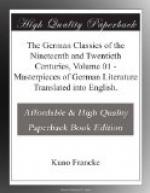Another method of procuring new metrical mediums of expression for the new wealth of emotions was to borrow. Klopstock naturalized antique metres, or rather made them familiar to the school and to cultivated poets, while on the other hand Heine’s derision of August von Platen’s set form of verse was welcomed in many circles, and even the elevated poems of Friedrich Hoelderlin, which approached the antique form, remained foreign to the people, like the experiments of Leconte de Lisle in France; in Italy it fared otherwise with Carducci’s Odi barbare. Only one antique metre became German, in the same sense that Shakespeare had become a German poet; this was the hexameter, alone or in connection with the pentameter; for the ratio of its parts to one another, on which everything depends in higher metrics, corresponded, to some extent, to that of the German couplets. For the same reason the sonnet—not, however, without a long and really bitter fight—was able to win a secure place in German reflective lyric poetry; indeed it had already been once temporarily in our possession during the seventeenth century. Thus two important metres had been added to German poetry’s treasure house of forms: first, the hexameter for a continuous narrative of a somewhat epic character, even though without high solemnity—which Goethe alone once aspired to in his Achilleis—and also for shorter epigrammatic or didactic observations in the finished manner of the distich; second, the sonnet for short mood-pictures and meditations. The era of the German hexameter seems, however, to be over at present, while, on the contrary, the sonnet, brought to still higher perfection by Platen, Moritz von Strachwitz and Paul Heyse, still exercises its old power of attraction, especially over poets with a tendency toward Romance art. However, both hexameter or distich and sonnet have become, in Germany, pure literary forms of composition. While in Italy the sonnet is still sung, we are filled with astonishment that Brahms should have set to music a distich—Anacreon. Numerous other forms, taken up principally by the Romantic school and the closely related “Exotic School,” have remained mere literary playthings. For a certain length of time the ghasel seemed likely to be adopted as a shell to contain scattered thoughts, wittily arranged, or (almost exclusively by Platen) also for mood-pictures; but without doubt the undeservedly great success of Friedrich von Bodenstedt’s Mirza Schaffy has cast permanent discredit on this form. The favorite stanza of Schiller is only one of the numerous strophe forms of our narrative or reflective lyric; it has never attained an “ethos” peculiar to itself. Incidentally, the French alexandrines were the fashion for a short time after Victor Hugo’s revival of them was revivified by Ferdinand Freiligrath, and were recently used with variations by Carl Spitteler (which, however, he denies) as a foundation for his epic poems. So, too,




